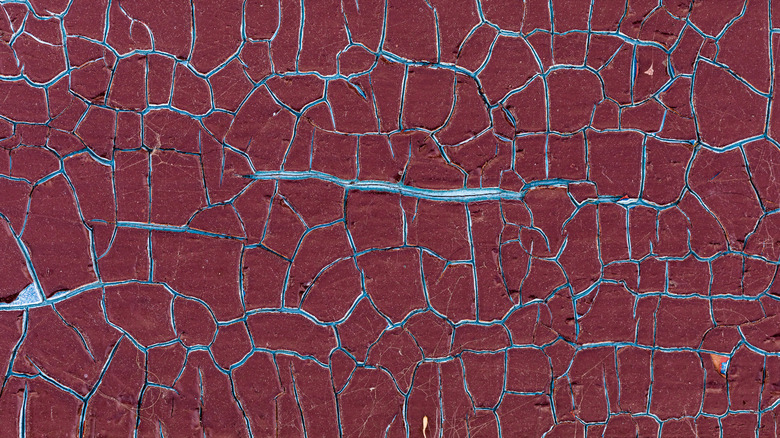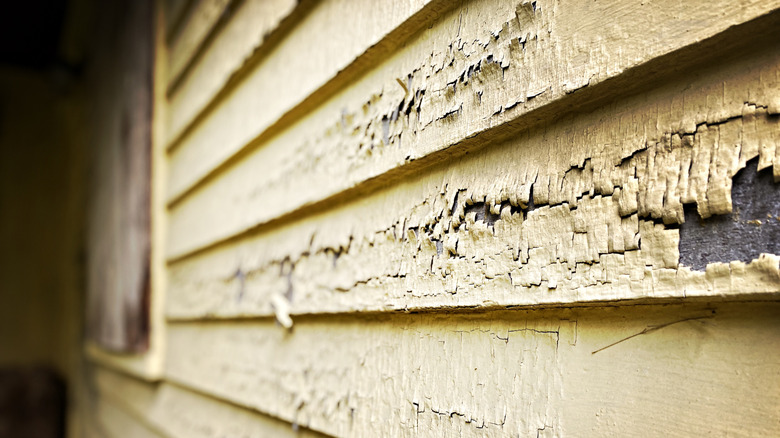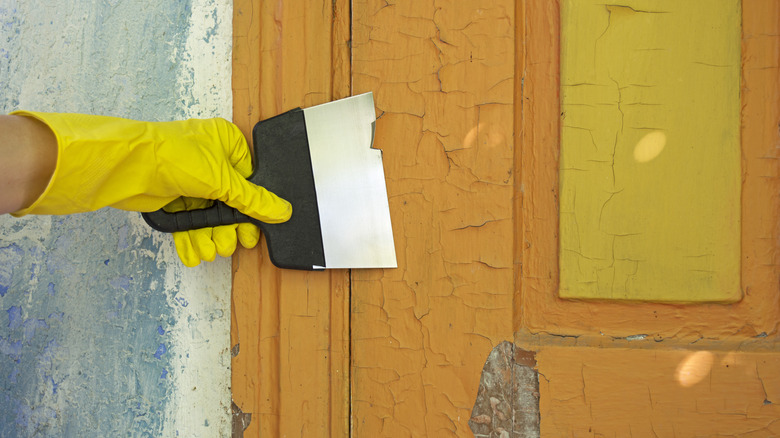What It Means If Your Paint 'Alligators' (And Is It More Likely To Happen In The Summer?)
From stained glass windows to intricately carved plaster, parquet floors to cased openings, there are plenty of features that add charm to historic homes. But when it comes to older houses that have been coated with oil-based exterior paint, fluctuating temperatures can create a crackled effect that makes even the finest properties look weathered and worn. According to Nick Slavik, proprietor of Nick Slavik Painting & Restoration Co., this scaly effect is called "paint alligatoring", a phenomenon you'll only see on houses that haven't been painted in several decades.
In an exclusive interview with House Digest, Slavik said alligatoring "is an indication of the old, dry, weathered condition of the paint." He explained that it happens to older homes coated with paints that don't have modern "elastomeric" ingredients. "We most commonly see this on homes built between 1880-1940 when oil based paint was most commonly used," Slavik explained. "When it weathers it gets dry, brittle and shrinks in comparison to the wood — which is a substrate that moves with temp and humidity," he added. It's these changes, which are typically more profound during the summer, that cause older paint to separate from wood siding or shingles on older homes. As it flakes off, it creates a patterned effect that resembles the skin of an alligator.
Alligatoring paint can lead to rot and structural issues over time
A crackled effect is among the faux painting techniques that will make a big difference in your home when used sparingly on a chair or table. But an exterior is covered in alligatoring paint looks poorly maintained and can lead to serious moisture issues. "Alligatoring occurs over a long period of time, and not within one season or temp change," Nick Slavik told House Digest during his exclusive interview. Whether you paint the exterior of your home during warmer or cooler temperatures, he told us, the weather doesn't make much of an impact — it's the age and type of paint that matters. "Oil-based paint, older paint and enamels will have a tendency to [alligator]," Slavik noted.
"Alligatoring happens on exteriors most often — and I'd be hard pressed to remember a time when I saw interior alligatoring unless a historic home was not heated/ac'ed for decades," he explained. The restoration expert said that the three necessary elements for paint alligatoring are oil-based products, weather, and time. If you're restoring a historic home that has alligatored paint on either the interior or exterior, it's important to address it as soon as possible. If you can see cracks in the surface of the substance, you're already facing the possibility that moisture is creeping into any small crack it can find. This process lifts up the top layer of paint, peeling it away from either the layer below or the structure itself. On wood homes, alligatoring paint can lead to serious rot problems.
Modern exterior paints won't alligator like old oil-based formulas
During his exclusive interview with House Digest, Nick Slavik said that modern high-quality exterior or interior paint has an almost non-existant chance of alligatoring, save for cases of extreme weather or human error. "I have not seen paint applied in the last 50 years that have alligatored," he said. The restoration expert added that even if you used an oil-based interior enamel on a wood exterior, it could take anywhere from 10 to 30 years to replicate the condition. And though alligatoring isn't caused by lead paint, Slavik said "the paint that alligators is the same paint that typically includes lead" due to the age of these products. He explained that there is an overlapping timeline when it comes to oil-based exterior paints and lead paints, but that oil-based ingredients, not the lead, are the primary cause.
To fix alligatoring paint, you'll need to focus on proper surface prep, rot repair, and priming before you repaint. First, rid the surface of any flaking paint using a putty knife or chemical removers, depending on how many layers of paint need to be removed. Then, you should fill any cracks or holes before sanding the surface perfectly smooth. Take appropriate precautions to avoid lead paint exposure. Finally, before using a modern exterior paint with elastomeric properties that make it completely moisture-proof, use a high-quality primer to seal the wood exterior to create a super smooth surface for painting.


